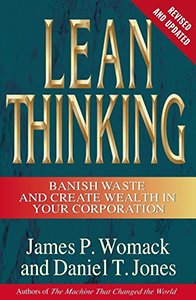Lean Thinking
“Lean Thinking: Banish Waste and Create Wealth in Your Corporation” is a book co-authored by James P. Womack and Daniel T. Jones. It expands on the principles of lean manufacturing first articulated in “The Machine That Changed the World” and applies them broadly to various industries and business processes. Here’s a summary of its key ideas:
Definition of Lean Thinking: Lean thinking is about maximizing customer value while minimizing waste. It focuses on creating more value with fewer resources through continuous improvement.
Five Principles of Lean Thinking:
– Specify Value: Understand what the customer values and align all activities to deliver that value.
– Identify the Value Stream: Map out all the steps in the process that deliver the product or service, from start to finish.
– Flow: Ensure that the value-creating steps are connected and occur in a smooth sequence.
– Pull: Let customer demand pull the product or service through the value stream.
– Perfection: Continuously strive for perfection by eliminating waste.
Waste Elimination: The book identifies seven types of waste (often referred to as “Muda” in lean terminology):
– Overproduction
– Waiting
– Transporting
– Inappropriate processing
– Unnecessary inventory
– Unnecessary motion
– Defects
Lean thinking aims to systematically identify and eliminate these wastes to improve efficiency and quality.
Continuous Improvement: Lean is not a one-time initiative but a philosophy of continuous improvement (Kaizen). Organizations are encouraged to empower employees to identify and solve problems, improve processes incrementally, and foster a culture of learning and innovation.
Respect for People: Lean emphasizes the importance of respecting and engaging employees at all levels. It encourages teamwork, collaboration, and providing the necessary tools and training for employees to contribute effectively to the organization’s goals.
Application Beyond Manufacturing: While lean principles originated in manufacturing, the book illustrates how they can be applied to various sectors including healthcare, services, construction, and software development. The focus remains on delivering value to customers efficiently and effectively.
Examples and Case Studies: Throughout the book, the authors provide numerous case studies and examples of organizations that have successfully implemented lean thinking. These examples illustrate the practical application of lean principles and their impact on organizational performance.
Overall, “Lean Thinking” serves as a comprehensive guide to understanding and implementing lean principles in order to eliminate waste, improve processes, and ultimately create more value for customers and stakeholders. It’s a foundational text for anyone interested in operational excellence and continuous improvement in business.

